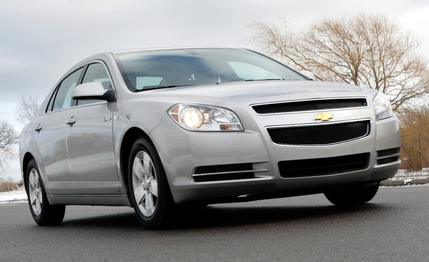 Short Take Road Test
Short Take Road Test
Readers who remember our May 2007 review of the Saturn Aura Green Line might wonder why we would waste our time writing about the mechanically identical Chevrolet Malibu hybrid. We wondered, too, until we got into the car and turned it on. The engine we described as being “as smooth and quiet as a riot in a minefield” in the Aura Green Line was again conspicuous in its operation, but this time because of its notable smoothness.
A quick call to Chevrolet produced a satisfactory answer. For 2008, a raft of improvements have been made to four-cylinder engines, both hybrid and nonhybrid, in all of GM’s mid-size cars. Included in the list of refinements are critical enhancements to the motor mounts and engine cradle. All aspects of operation in this hybrid application—start/stop, idle, acceleration, and cruising—are light-years better than those of the Aura we tested last year.
As “mild” hybrids, the Aura Green Line and the Malibu hybrid are incapable of the electric-only operation that enables other hybrids to achieve their lofty fuel-economy numbers and superior stealth in nighttime maneuvers. Rather, their batteries store electricity to spin the accessory drive with the engine off at idle and provide a modicum of assistance under acceleration.
Although the output of the 2.4-liter gasoline engine is nearly identical with or without the electrical assistance, the hybrid Malibu gets a taller final-drive ratio—3.05:1 compared with 3.91:1 in nonhybrid cars—to keep revs down and mpg up on the highway. The transmission ratios are the same in both cars’ four-speed automatics.
The battery assistance offsets the taller gearing, however, and the hybrid’s acceleration numbers are right on top of those of the last four-cylinder Malibu we tested: 0 to 60 in 8.8 seconds and the quarter-mile in 16.8 at 84 mph versus 8.7 and 16.7 at 83 mph. The Toyota Prius, in comparison, dogs to 60 in 11.3 seconds and lopes through the quarter in about the same time as a midpack Iditarod team, 18.3 at 76 mph.
In other g-generating ventures, the Malibu hybrid is competent but won’t impress enthusiasts, which is fine, as this is a vehicle aimed elsewhere in the market. Its handling is mediocre and would likely improve with better tires than the Uniroyal Tiger Paws that come on the car, although steering feel—slightly numb, but very nicely weighted—would not.
Braking from 70 mph takes a longish 187 feet, which would have trailed most of the entrants in our last compact-SUV comparo. Gentler stops can get a little jerky—but not aggravatingly so—as the transmission downshifts somewhat aggressively in order to charge the batteries.
Performance, as we are well aware, is among the last yardsticks buyers use to judge a hybrid. The deal closer is fuel economy, and the Malibu hybrid is rated by the EPA at 24 mpg city and 32 highway—figures that may disappoint people hoping for the astronomical fuel-economy numbers posted by the Prius, which is rated at 48/43 but struggles to scoot in front of that looming Freightliner during freeway merges.
The hybrid’s fuel-economy ratings best the base Malibu’s 22/30 by 2 in each category. Our observed mileage was 25 in the hybrid, 24 in the regular four-cylinder. With a $4000 premium for the hybrid, you’re looking at more than 60,000 miles of driving before you recoup your upfront cost. If gas prices continue to rise, that figure will drop, and it won’t be long before you’ll be saving a penny a mile.
Don’t think that the cost of stepping up to the hybrid includes much additional content beyond little green “H” badges, though, as the only bonus aside from the boosted fuel economy is automatic climate control—which is not available on any other Malibu—with two modes, normal and eco. To keep the engine quiet for longer intervals, eco mode allows a greater variance in cabin temperature before kicking on the A/C; normal is the “screw the birds and the trees and keep me cool” mode. Overall, options on the Malibu hybrid are limited to four: extra-cost paint, a sunroof, a power driver’s seat and pedals, and body-color side moldings.
Although the improvements to GM’s four-cylinder for 2008 make the Malibu hybrid a far better car than we expected it to be, it is still a compromise. Saving money up front with a cheaper hybrid system means you save less money at the pump with poorer fuel economy than that of most other hybrids. The truth is, for just slightly more money, Toyota’s Camry hybrid and the Nissan Altima hybrid—which uses the Toyota powertrain under license—are quicker and achieve better fuel-economy ratings than the Malibu. But if you really like the Malibu’s new look, this hybrid should satisfy.